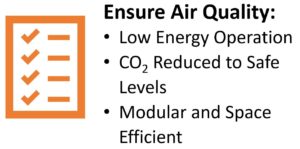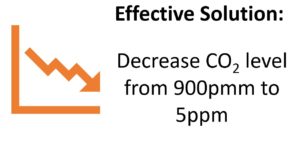NEW! CMS launches commercial CO2 capture system.
Carbon dioxide removal solution for enclosed spaces, making small cabins, mines and vessels habitable for long durations, while capturing the CO2 stream.
This commercial technology leapfrogs existing solutions to be small, light, modular, and energy efficient.
Why Does It Matter?
In enclosed spaces, such as spaceships and submarines, with large numbers of people exhaling, CO2 builds up, compromising personal safety. This CO2 must be removed. In locations where safety is paramount and energy and space are at a premium, the CMS solution is superior.
CMS and a partner successfully piloted a novel membrane liquid-based removal system to remove CO2 for continuous adsorption and capture of CO2, overcoming the challenges with traditional gas phase separation solutions.
The CMS membrane is now commercially available for your application!
Why CO2 Removal for Enclosed Spaces
Wherever they go human beings produce carbon dioxide with every breath they take. This is particularly problematic in enclosed spaces like aircrafts, mines, marine vessels, and enclosed workspaces, where CO2 builds up and lowers air quality, reducing the time the space can be occupied. Due to the low concentration of CO2, a traditional gas phase separation solution is not efficient.
How It Works
CO2 is removed via a hybrid system. CO2 is absorbed into a liquid and removed from there via a pervaporation membrane system. Hybrid liquid absorption and membrane systems hold promise for carbon capture because they can be effectively scaled to the size of the application and can remove low levels of CO2 to keep enclosed atmospheres at optimal air quality.
A Superior Solution
The goal of this product is to enable the use of small, efficient liquid absorption systems to remove CO2 with superior space and operational efficiency. Pressure swing adsorption and other incumbent CO2 removal technologies are not space or weight efficient, nor do they capture the CO2 for safe disposal. Continuously removing CO2 from the liquid avoids removing waste of the liquid absorbent and ensures maximum CO2 removal from the atmosphere. CMS uses pervaporation membranes to remove dissolved CO2 from liquid absorbers.
The fluoropolymer pervaporation membrane is stable to harsh chemistries, making the membrane compatible with most liquid absorbents. The membrane can reduce the dissolved CO2 levels from <1% to single ppm levels in the absorbent liquid. The hybrid membrane liquid absorbent system was piloted with a partner organization in early 2022. The system is designed to increase the air quality in enclosed spaces and extend occupation time. The membrane is commercially available from CMS and was designed to ensure optimal fluid dynamics and space efficiency. To learn more please visit compactmembrane.com or Christine Parrish at cparrish@compactmembrane.com.



